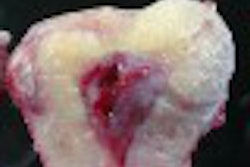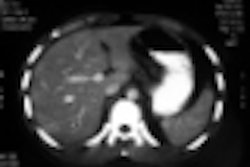CHICAGO - A new company debuting at this week's RSNA meeting is taking ultrasound into a new direction by applying cross-sectional imaging techniques to the modality. Advanced Diagnostics (ADI) hopes to get the best of both worlds with Avera, a scanner that has the real-time dynamic imaging capabilities of ultrasound and the spatial and contrast resolution of x-ray.
Unlike traditional ultrasound systems, which assemble their images from sound waves reflected back from the body to the scanner's transducer, ADI's system uses a 7-inch circular detector on the other side of the patient to collect sound waves.
ADI calls the technology diffractive energy imaging (DEI), although it is also known as through-wave transmission ultrasound. The technology produces dynamic images that look fluoroscopic but don't subject patients to ionizing radiation, according to Denis O'Connor, the medical imaging veteran who joined the company last year as chairman and CEO.
Breast imaging is the first application that ADI is targeting, with the system acting as an adjunct to conventional mammography systems. ADI's product is similar in size to a small CT scanner, requiring an 8 x 8-foot room for siting. The patient lies prone on the scanner table, with the breast suspended in a water bath. Ultrasound waves are transmitted through the water bath, through the breast, and onto a detector.
The transmission process creates a diffraction pattern through the object being imaged. The diffracted ultrasound waves are then focused on a pair of acoustic lenses and combined with a pure ultrasound wave that is an exact replica of the original transmission beam. The waves strike the system's detector, and finally are illuminated with a laser that is projected onto a charge-coupled device (CCD) digital camera, thus producing the final image.
In its RSNA booth, ADI is emphasizing the breast biopsy capabilities of the system as a work-in-progress. Mammography is an attractive market for the firm because Avera uses neither compression nor ionizing radiation, both drawbacks for conventional mammography studies. The planar nature of the system -- collecting cross-sectional image slices -- can also have advantages, according to O'Connor.
Although breast imaging is the first market, Avera can be used for any kind of soft-tissue imaging for which ultrasound is also appropriate, according to O'Connor. Orthopedic and prostate imaging are potential applications. The company is also exploring the use of ultrasound contrast agents for vascular applications.
ADI was founded five years ago to commercialize the through-wave ultrasound technology, which was originally developed at R&D firm Batelle Labs in Richland, WA. In addition to O'Connor, ADI's executive lineup includes ATL/SonoSite veteran Doug Tefft, and Michael Baker, who served stints with digital x-ray firm Swissray International and PACS vendor Loral. The company recently secured a $4 million round of financing.
Avera has 510(k) clearance for use as a general imaging device, and ADI plans to launch the system in the first quarter of 2001. ADI estimates that the scanner will carry a list price between $175,000 to $250,000, about the same price as a mid-range to high-end ultrasound scanner.
By Brian Casey
AuntMinnie.com staff writer
November 27, 2001
For the rest of our coverage of the 2001 RSNA meeting, go to our RADCast@RSNA 2001.
Copyright © 2001 AuntMinnie.com



















